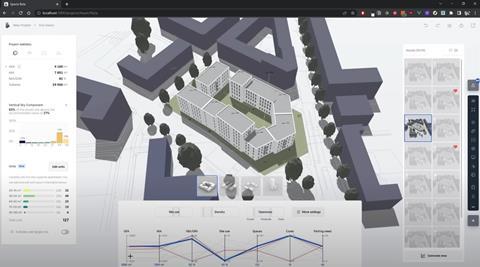In the fourth article of this series, Keir Regan-Alexander looks at ‘Leveraged Drafting’ and how it could dramatically increase productivity

The promise of what I’m calling ‘Leveraged Drafting’ is to speed up the often boring and mechanical taskwork that we ask highly skilled professionals to spend lots of valuable time on and which require no extraordinary insight or creative judgement. It’s perhaps most directly applicable to: RIBA 3 / AIA DD.
Revit, the pre-eminent BIM friendly application for architects and engineers, offers enormous flexibility in how we compile 3D models and structured databases for buildings. However, in enabling this complex functionality, Autodesk has also created an impenetrable UX that takes 6 months or longer to really master for typical users. Architects who want to play with computational design (to achieve greater productivity and scale up their efforts) must first also learn Grasshopper and Dynamo scripts in addition - which is a high bar.
Here is where new generative tooling is aiming to reduce the grunt work and pain - by making computational design, with weighted parametric controls more easily accessible during every day work and accessed via a much more user-friendly interface. These tools could open the door to the utility of parametric design beyond the leaders of the parametric style movement of architecture that we have come to know so well (by exponents like Zaha Hadid Architects, Coop Himmelblau and BIG).
While parametric tooling has so far enabled us to realise and control complex geometric arrays, their fundamental value lies in using mathematical rules to leverage your design inputs and therefore could just as well bring huge productivity benefits to more typical urban form-making, masterplanning and the typology-specific building design of more mainstream projects.
There are now a number of disruptors in this area aiming to bring computational design to the masses. For example when you design a new speculative office building and you want to test-fit the space for occupiers - once you have the core and shell defined, a tool like Laiout can now do that very efficiently, working to a clear space brief and occupancy target.
The Beta launch of Spacio is demonstrating “whole 3D block” generation from just a couple of input clicks. You then define and refine the parameters you desire and the tool will simulate VSC and daylight factor results live inside the model and on every version, without the need of an external consultant.
This approach is very flexible, combining automated whole block generation with SketchUp-like push/pull controls. With the ability to create local libraries for building typologies, this could totally change how we approach early stage feasibility work and optioneering.

On the theme of reducing drafting time, some companies are also looking into how we can create BIM models more easily. While the UK now mandates Level 2 on public projects, recruiting for both design and Revit skills (combined) is still very difficult. In-house training is a great burden on peoples’ time and the licencing for software packages like Revit is extremely costly compared to fee income.
One of the reasons why BIM adoption still is not easy to achieve for many regular practices is the skills shortage and the time it takes to get up to speed. There is a morale cost too – heavy CAD-based work can ultimately lead to very unfulfilling work for architects whose value is best expressed with critical design thinking, not geometric database creation.
Hypar is now promoting early versions of a “text-to-BIM” functionality which opens up the potential for users to describe the components or models they wish to create, the parameters they need to control as constraints to a system and the software will automatically create the geometry and metadata. Early versions look fairly limiting in scope, but they are still extraordinary examples of what will be possible soon - the idea would’ve been unthinkable just a few months ago. One could imagine the next logical step of progression would be “image-to-bim” or “sketch-to-bim”.
Be Careful of:
A. Typological Nuance. Many of the qualities of a building typology plan cannot be easily distilled into numerical and geometric rulesets. Things will get really interesting when these platforms begin to infer more nuanced issues of good adjacency, status, hierarchy and privacy for example. Before we start to get comfortable in the idea that these concepts rely on innately human judgement, it’s probably best to presume that these qualities can be expressed in code and they are already on the roadmap…
B. Deterministic Algorithms. When we are talking about parametric rulesets then the outcome is preprogrammed by the inputs. Ideally you have access to adjust the weighted dials on these inputs to get the outcome you desire. Some products are offering very detailed controls over each parameter and even the ability for users to define their own. This should be encouraged; yes we want help with boring cad production, but we still need full control of the design and the dials that change it.
C. Copy Pasta. The allure of auto generated geometry is real - it’s quick and efficient, but the ruthless repetition of building components could start to feel mechanical very fast. Are we sure the components and cad blocks we’re repeating are fit for purpose in the first place? We need to find balance between efficiency and standardisation for efficiency’s sake. We also need to make space for nuance, rule breaking and surprise are important in the creation of places too - and these can’t be easily planned for.
>> Also read: The first movers creating Generative Design & AI tools for architecture
>> Also read: Generative Design & AI Trends: ‘Auto Optioneering’
>> Also read: Generative Design & AI Trends: ‘Hybrid Collage’
Postscript
Keir Regan-Alexander is an AEC Domain Expert and Consulting Director operating at the intersection of architecture practice, sustainable development and software design. Connect on LinkedIn
















No comments yet